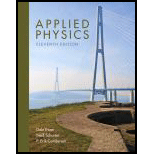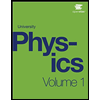
Concept explainers
Kurt s standing on a steel beam 275.0 ft above the ground and throws a hammer straight up at an initial speed of 40.0 ft/s. At the instant he releases the hammer, he also drops a wrench from his pocket Assume that neither the hammer nor the wench nits anything while in night (a) Fine the time difference between when the wrench and the hammer hit the ground (b) Find the speed at which the wrench hits the ground, (c) Find the speed at which the hammer hits the ground, (d) How long does it take for me hammer to reach its maximum height? (e) How high above me ground is the wench at me time the hammer reaches its maximum height?
Want to see the full answer?
Check out a sample textbook solution
Chapter 4 Solutions
Applied Physics (11th Edition)
Additional Science Textbook Solutions
Life in the Universe (4th Edition)
College Physics (10th Edition)
Essential University Physics: Volume 1 (3rd Edition)
The Cosmic Perspective
Tutorials in Introductory Physics
Physics: Principles with Applications
- Two ducks, Donald and Cassiopeia, are gliding gracefully toward eachother along a pond, in a straight line. Donald is initially moving at v =0.500 m/s, and begins accelerating at 0.100 m/s2 at t = 0 s. Cassiopeiamoves at a constant speed of v = 0.700 m/s. If they are initially separatedby 25.0 m, where will they collide? Take Donald’s initial position as theorigin. How long will it take for them to collide?arrow_forwardIn a scene in an action movie, a stuntman jumps from the top of one building to the top of another building 4.00 m away. After a running start, he leaps at an angle of 15.0o with respect to the flat roof while traveling at a speed of 5.00 m/s. Will he make it to the other roof, which is 2.50 m shorter than the building he jumps from?arrow_forwardAn inquisitive physics student and mountain climber climbs a 51.0-m-high cliff that overhangs a calm pool of water. He throws two stones vertically downward, 1.00 s apart, and observes that they cause a single splash. The first stone has an initial speed of 2.06 m/s. (b) What initial velocity must the second stone have if the two stones are to hit the water simultaneously?arrow_forward
- Do the d part In a cricket match, a batsman hits a ball at an angle of 36o from the horizontal with an initial speed of 15.5 m/s. Assuming that the ball moves in a vertical plane, find (a) the time at which the ball reaches the highest point of its trajectory, (b) its maximum height, (c) its time of flight and range, and (d) its velocity when it strikes the groundarrow_forwardA football player kicks a ball at an angle of 36 degrees from the horizontal with an initial speed of 15.5 m/s. Assuming that the ball moves in a vertical plane, finda) The time, t 1 at which the ball reaches the highest point of its trajectory.b) Its maximum heightc) Its time of flight and range, andd) Its velocity when it strikes the groundarrow_forwardA projectile is thrown from the top of a building with an initial velocity of 30 m/s in thehorizontal direction. If the top of the building is 30 m above the ground, a) how long isthe projectile in the air? b) With what speed and angle will the projectile be moving justbefore it strikes the ground? (Hint: final speed = 38.6 m/s)arrow_forward
- A Wide Reciever is running along the sideline straight towards the goal at a constant speed. When he is 27 m away from the goal line he cathces the ball, but theire is a cornerback 12 m behind him moving with a connstant speed of vc=9.0 m/s what speed should the wide reveiver have to make sure he reaches the goal line just as the cornerback reaches him.arrow_forwardA ball is thrown into the air at 60° angle to the ground, takes a parabolic path, and is in the air for a total time of 4 s. If the upward direction from the ground is positive, what is the best estimate of the ball’s velocity at a time 3 s after it leaves the ground?arrow_forwardAn Olympic long jumper is capable of jumping 8.0 m.Assuming his horizontal speed is 9.1m/s as he leaves the ground, how long is he in the air and how high does he go? Assume that he lands standing upright—that is, the same way he left the ground.arrow_forward
- To find the height of an overhead power line, you throwa ball straight upward. The ball passes the line on the way upafter 0.75 s, and passes it again on the way down 1.5 s after itwas tossed. What are the height of the power line and the initialspeed of the ball?arrow_forwardA particle travels, to the right, at a constant rate, of 6.5m/s. It, suddenly, is given a vertical acceleration of 3.2m/s22, for 3.9s. What is its direction of travel, after the acceleration, with respect to the horizontal? Answer between -180 and +180. What is the speed at this time? Answer in units of m/s.arrow_forwardball is thrown vertically apart from the top of a building 288 feet tall with an initial velocity of 48 feet per second. The distance s (in feet) of the off from the ground after t seconds is s(t)=288+48t-16t^2 a) after how many seconds does the ball strike the ground? b) after how many seconds will the ball pass the top of the building on it way down?arrow_forward
 University Physics Volume 1PhysicsISBN:9781938168277Author:William Moebs, Samuel J. Ling, Jeff SannyPublisher:OpenStax - Rice University
University Physics Volume 1PhysicsISBN:9781938168277Author:William Moebs, Samuel J. Ling, Jeff SannyPublisher:OpenStax - Rice University
